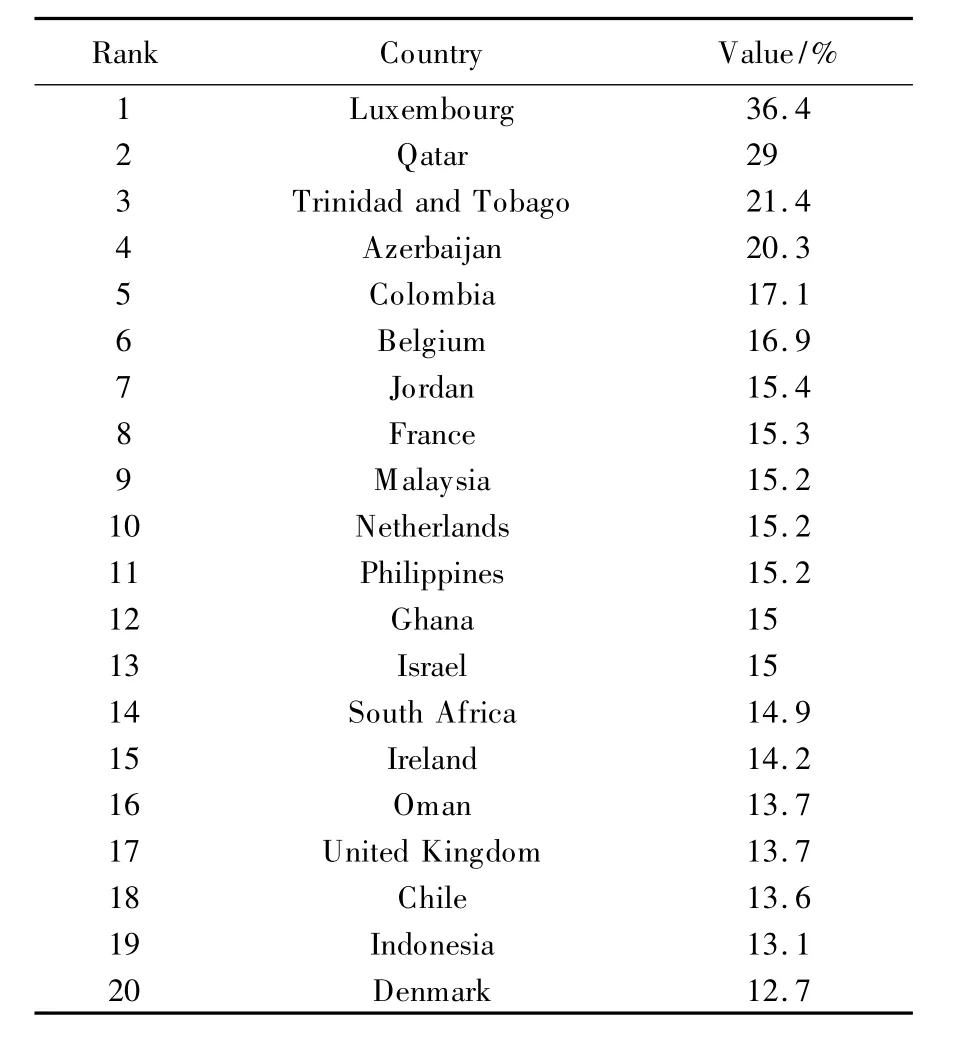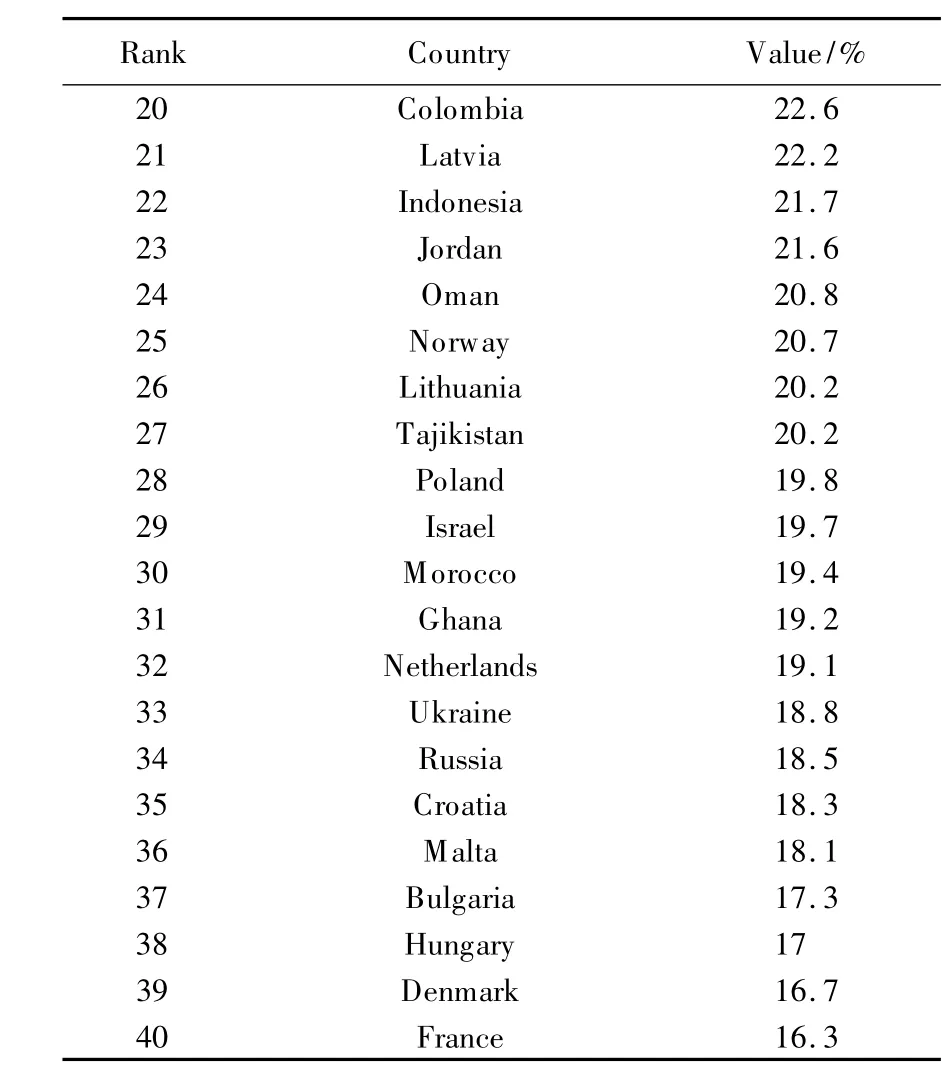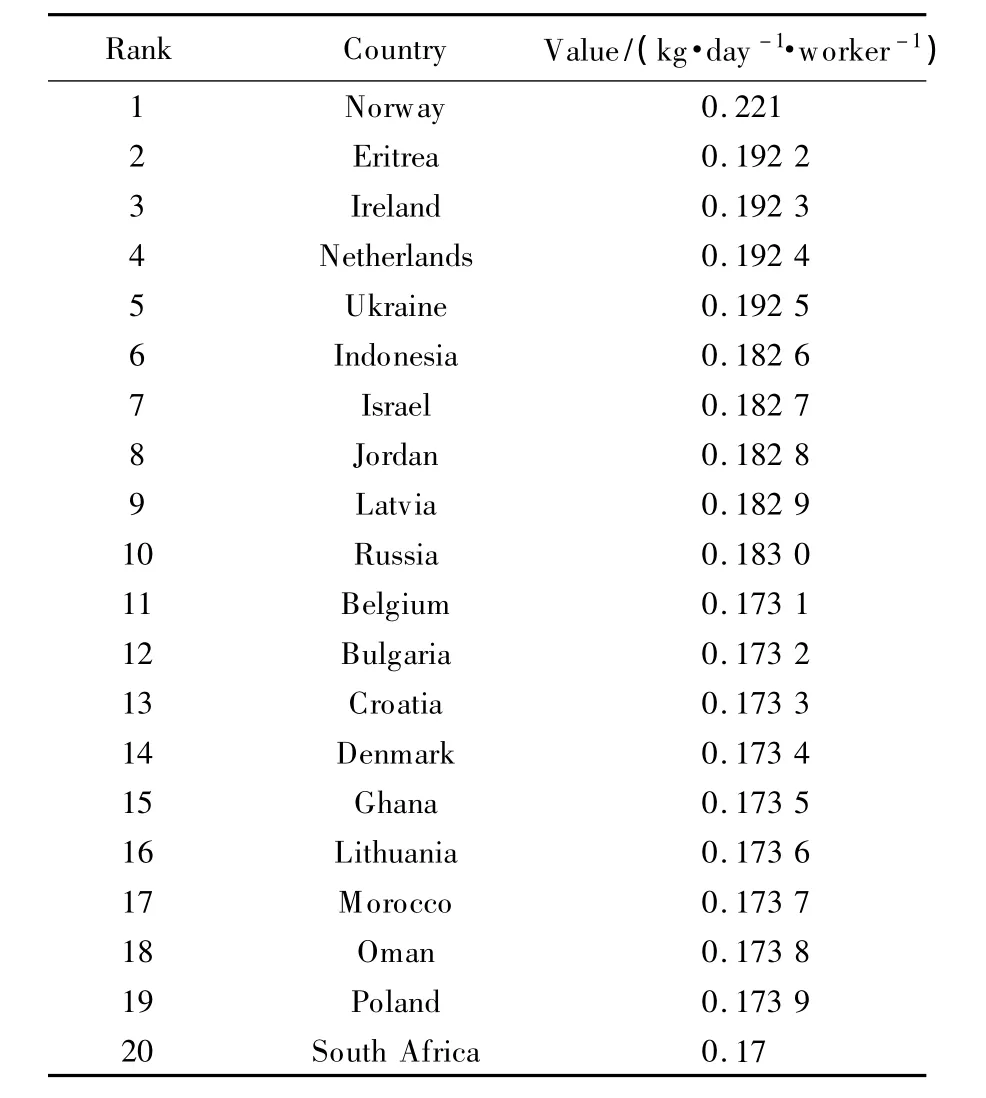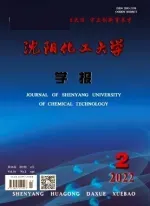Water Problems in Ghana and Sustainable Development
ATTA-EWUSI Ama, WANG Li, XU Zi-jiao
(1.University of Cape Coast,Cape Coast 00233,Ghana; 2.Shenyang University of Chemical Technology,Shenyang 110142,China)
The provision of safe drinking water for the world's 1.3 billion deprived populations has become one of the top most priorities of many governments in recent years.In the year 2000,more than a hundred and fifty governments the world over launched an ambitious plan to halve the number of people without access to safe drinking water by the year 2015[1].Water resources such as streams,rivers,lakes,dams,water falls,underground and rain water abound in Ghana[2].However,the major headache has been how to make these sources safe for human consumption as these sources are affected by natural and anthropogenic influences as well as point and non-point impacts.Water pollution and wasteful use of fresh water threaten development projects,agriculture.Discharge of toxic chemicals,over pumping of aquifers,long-range atmospheric transport of pollutants and contamination of water bodies with substances that promote algal growth(leading to eutrophication)are some of today's major water quality degradation[1].
Direct contamination of surface waters with metals in discharges from mining,smelting and industrial manufacturing is a long standing phenomenon[3].Contamination of water by synthetic micro pollutants results either from direct discharge into surface waters or after transport through the atmosphere.Today,there is trace contamination not only of surface waters but also of ground water bodies,which are susceptible to leaching from waste dumps,mine tailings and industrial production sites[4].
According to Allotey and Gyamfi[3],problems of water management in Ghana is mostly attributed to the paucity of accurate and reliable database on the water resource itself including some other related factors.With regards to water pollution,the Ghana Chamber of Mines has admitted that not much has been achieved in the last decade of pollution abatement measures[4].No comprehensive research has ever been conducted with respect to pollution levels along the rivers and streams in Ghana.
1 Ghana's Water Resources
All recharge to water resources is precipitation.Rainfall in Ghana is between March and November;2 240 mm of annual rainfall is recorded in the extreme southwest,it reduces eastward to 800 mm at the southeastern part.It then increases to 970 mm at the northeastern part of country.Freshwater resources are classified into groundwater and surface water.In Ghana the surface water/ river basins have been classified into three systems.They include the Volta Basin System,which is made up of the Daka,Oti,Black and White Volta and Lower Volta River,the Southwestern Basin System encompassing the Bia,Tano,Ankobra and Pra rivers,and the coastal basin system which consist of Tordzie,Densu,Ayensu,Ochi-Nakwa and Ochi-Amissah rivers.All these water systems carry huge untapped quantities of water into the sea annually.Lake Bosomtwe situated near Kumasi,formed by meteoritic crater is also a surface water resource.All rivers,pose a great opportunities from the construction of Hydroelectric and Water Supply dams to the construction of Irrigation Systems.
Groundwater is found almost everywhere in Ghana,except some part of the Voltain where economic quantities of groundwater is scarce.Groundwater in Ghana is less susceptible to pollution.Groundwater has been a major source of water supply to rural communities,without the reach of treated water supply systems.Groundwater resource is cheap to subscribe despite the fact that an initial capital investment is required.It can be tapped by both households and individuals at a relatively economic cost.
2 Water Pollution in Ghana
Despite the role water plays in the existence of man on earth;we have not taken the necessary care of our water bodies especially in Ghana.Industrial,domestic and other activities have polluted our water bodies.Small and Medium Scale Industries are culprits of this offence.They direct their waste liquids directly into nearby streams and rivers.In our individual houses,with the exception of human waste,all other waste liquids are directed into our water bodies(Fig.1).

Fig.1 Some water problems in Ghana
Could we even imagine that during downpour,some households empty the contents of their septic tanks straight into the runoff.It is not worth to talk about the polythene bags and bottle and their provocative contents floating on and around our river bodies.Every river in Accra and other cities have been turned into cesspool and you would be turned down by the miasma that would penetrate into,and arrest your breath when you approach them.People in broad-day-light attend to natures call right in the middle of the Odaw and other river bodies right in the middle of the capital city.Rivers in Accra have been turned to sources of‘tourist repulsion’instead of‘tourist attraction’.They should been converted into canals for boats,and other recreational activities.In farming communities,some farmers,farm at the river banks,destroying the vegetation cover and worse of all,introduce harmful chemicals into the rivers.Yet in rural areas,refuse disposal points are situated in marshy areas and river banks.
3 Causes of Water Pollution in Ghana
3.1 Oil Spillage
Tema being one of Ghana's industries cities has many industries whose waste products are mainly oil.This mostly occurs during the production,distribution,and refining stages.These oil spills enter oceans and rivers from faulty and accident tankers as well as offshore oil wells.Also the oil may pollute water from our homes where we spill oil in our gutters which therefore gets into our water bodies.
3.2 Sewage
Water pollution also occurs due to untreated sewage from plants,animals,and humans.They create offensive odour,use up the oxygen in waters,and make rivers impossible for human use.A typical example is Tema——New Town,where untreated sewage,are transported into the Chemu Lagoon in the town.If too much oxygen is used,organisms in the water cannot survive.Sewage that is treated could also be harmful because they contain nitrates and phosphates that increase the growth of algae.The algae upset the natural or free flow of rivers and other water bodies.
3.3 Agriculture
Agriculture,including commercial livestock and poultry farming,is the source of many organic and inorganic(pesticides and other agro-chemicals)pollutants in surface waters and groundwater.These contaminants include both sediment from erosion cropland and compounds of phosphorus and nitrogen that partly originate in animal wastes and commercial fertilizers.Animal wastes are high in oxygen demanding material,nitrogen and phosphorus,and they often harbor pathogenic organisms.Wastes from commercial feeders are contained and disposed of on land;their main threat to natural waters,therefore,is from runoff and leaching.
3.4 Mining
Because mining is one of Ghana's major activities,there are usual discharges from mining firms in the form of acid mine-water.Also acid rain contributes to water pollution.Some miningrelated heavy metals(such as Lead,Arsenic,Copper,Zinc and Iron)may originate in industrial dischargers,run off from city streets,mining activities,leachate from landfills and a variety of other sources[5].These toxic chemicals,which are generally persistent in the environment,can cause death or reproductive failure in fish,shellfish and wildlife.In addition,they can accumulate in animal and fish tissue,be adsorbed in sediments,or find their way into drinking water supplies,posing long term health risks to humans[6].Surface mining including artisanal mining affects water availability to people through the use of large volumes of fresh water for processing as well as water pollution from discharged mine effluent and seepage from tailings and waste rock impoundments.These pollutants causes Water-borne diseases in Ghana (Table 1).

Table 1 Inorganic water pollutants in Ghana
3.5 Biological Infections
(1)Bacterial infections:Typhoid,Cholera,Paratyphoid fever,bacillary dysentery.
(2)Viral infections:Hepatitis(jaundice),Poliomyelitis.
(3)Protozoan infections:Amoebic dysentery,Guinea worm infestation.
3.6 Iron and Manganese
High concentrations of iron in groundwater occur in many places throughout Ghana.They are generally associated with acidic groundwater or anaerobic sources[7].Manganese typically occurs in association with iron,though concentrations are much lower in Ghanaian ground waters.Few observed results exceed the WHO recommended guideline(0.5 mg/L,health based limit).Results from two comprehensive BGS surveys of groundwater(Obuasi,Ashanti Region and Bolgatanga,Upper East Region) indicate that,respectively 3%and 10%of potable groundwater sources exceeded the WHO guideline for manganese[8].
3.7 Fluoride
The dominant controls on fluoride occurrence in ground water are climate and geology.The regions of Ghana most vulnerable to high fluoride concentrations(and associated dental fluorosis) are the arid zones of the north and areas where bedrock geology is dominated by granite.The Upper Regions of Ghana are therefore considered to be the most likely areas to experience potential problems.Concentrations of fluoride in excess of 1.5 mg/L(up to 3.8 mg/L)have been observed in Bolgatanga and Sekoti(Upper East Region)in close association with granitic rock types[8].Occurrence of dental fluorosis is common in these areas.Ground waters in granitic rocks of the southwest plateau are considered to be less at risk because of higher rainfall and its diluting effect on groundwater compositions.
3.8 Arsenic
Arsenic is present in rocks,soils,water,and living organisms at concentrations of parts per billion to parts per million[9].Natural weathering of rocks and soils adds about 40 000 tones of arsenic to the oceans annually,accounting for< 0.01 mg/L input to water on a global basis[10].Arsenic poses a potential problem locally in Ghanaian groundwater because of the abundance of arsenicbearing minerals,particularly arsenopyrite,which occurs in close association with gold in sulphidemineralized veins.Surface waters close to gold mines have been found to contain relatively high concentrations(>0.01 mg/L,the WHO recommended guideline)of arsenic in localised areas.However,analysed ground waters have not revealed major arsenic problems.Of 78 potable groundwater samples analysed by BGS in the Obuasi goldmining area,only 14(18%)exceeded the WHO guideline(maximum concentration,0.064 mg/L).In the Bolgatanga area,where sulphide mineralization is present but less prevalent,only 2 samples out of 118 analysed(<2%)exceeded the guideline value,although one of these was as high as 0.14 mg/L.
3.9 Organic Water Pollutants
Industry shares of emissions of organic water pollutants refer to emissions from manufacturing activities as defined by two-digit divisions of the InternationalStandard Industrial Classification (ISIC)(Table 2~Table 5).Emissions of organic water pollutants are measured by biochemical oxygen demand,which refers to the amount of oxygen that bacteria in water will consume in breaking down waste.This is a standard water-treatment test for the presence of organic pollutants.Ghana's has one of the highest GDP per capita in West Africa.The country has a diverse and rich resource base with gold,timber,cocoa,diamond,bauxite,and manganese being the most important source of for-eign trade.In 2007,an oilfield which may contain up to 3 billion barrels of light oil was discovered,all these resources are exploited without or little regards to the environment.

Table 2 Water pollution,chemical industry(%of total BOD5emissions)-Water pollution-Environment-World Development Indicators(2003)

Table 3 Water pollution,food industry(%of total BOD5 emissions)-Water pollution-Environment-World Development Indicators(2003)

Table 4 Organic water pollutant(BOD5)emissions(kg per day per worker)-Water pollution-Environment-World Development Indicators(2003)

Table 5 Renewable internal freshwater resources per capita(cubic meters)-Freshwater-Environment-World Development Indicators(2008)
4 Sustainable Water Management
Healthy freshwaterecosystemsprovide a wealth of goods and services for society,but our appropriation of freshwater flows must be better managed if we hope to sustain these benefits and freshwater biodiversity.We offer a framework for developing an ecologically sustainable water management program,in which human needs for water are met by storing and diverting water in a manner that can sustain or restore the ecological integrity of affected river ecosystems.Six-step process includes:(1)developing initial numerical estimates of key aspects of river flow necessary to sustain native species and natural ecosystem functions; (2)accounting for human uses of water,both current and future;(3)assessing incompatibilities between human and ecosystem needs;(4)collaboratively searching for solutions to resolve incompatibilities;(5)conducting water management experiments to resolve critical uncertainties that frustrate efforts to integrate human and ecosystem needs;and(6)designing and implementing an adaptive management program to facilitate ecologically sustainable water management for the long term.
5 Integrated Water Resources Management
In terms of integrated water resources management,there are 3(three)management areas,i.e.watershed management,water sources management and water use management that should be implemented integrally.Watershed management consists of managing spatial planning,land use monitoring and control,forest,land rehabilitation and soil conservation,and restoration and management of water recharge area.Water sources management consist of managing water quantity,water quality,flood management,river infrastructure,and river environmental.Whereas,water use management consist of managing waste water,efficient use of water,irrigation water,and waste water system.
6 Watershed Management
Activities of all land uses within watersheds impact the water quality of down gradient water bodies.Point and nonpoint sources of pollution in a watershed contributenutrients,bacteria,and chemical contaminants to waterways.Watershed management encompasses all the activities aimed at identifying sources and minimizing contaminants to a water body.Watershed Management is to restore and protect watersheds through:proper planning and management of water resources and their uses; reducing the impacts ofnonpoint sources of pollution on water resources;regulating activities for soil conservation and waterway and wetlandsprotection; forming partnershipsand building local capacity to restore and protect water resources,including drinking water sources;and educating citizens about watersheds and watershed management.
7 Water Pollution Control Tools
The main methods were used in Ghana as below:
(1)Biological wastewater treatment:uses microorganisms to break down complex materials present in the wastewater.It can aid with BOD5reduction,odor control and more.
(2)Archimedes screws:Originally applied for drainage and irrigation,today Archimedes screws/screw pumps are commonly used in sewage treatment plants because they cope well with varying rates of flow and suspended solids.
(3)BOD5Level Reduction:Having a safe BOD5level in wastewater is essential to producing quality effluent.If the BOD5level is too high then the water could be at risk for further contamination,interfering with the treatment process and affecting the end product.
(4)Wastewater Clarification,or sedimentation:is a common and essential process in municipal and industrial wastewater treatment plants.
(5)Wastewater disinfection systems:prevent the growth of microorganisms,or pathogens,that produce human diseases.Careful measures must be taken when trying to do away with these microorganisms.
(6) Dissolved metals removal:Industrial wastewaters containing dissolved metals are treated to reduce the metal contaminants to meet discharge requirements and/or achieve the water quality level needed for reuse and recycling.
(7)Hazardous wastes treatment:are generated as the result of treatment steps performed on industrial wastewaters prior to discharge,or contaminant-containing ground waters.The treatment process produces a residual waste,including sludge and spent media.
(8)Chrome Removal:The US EPA has established standards that require the destruction of chromates prior to discharge to avoid the potential risks of surface and drinking water contamination.
Virtually every industry uses water in its process to one degree or another to make a product or provide a service.This use can be either direct,such as for the production of steam,or indirect,such as for rinsing water for semiconductor chips.
(9)Industrial Waste Water Pre treatment: Virtually every industry uses water in its process to one degree or another to make a product or provide a service.This use can be either direct,such as for the production of steam,or indirect,such as for rinsing water for semiconductor chips.
(10)Nutrient removal:is achieved by reducing the levels of nitrogen and phosphorus levels with advanced wastewater technologies.Higher quality wastewater effluent is the result of this process.
(11)Oil Water Separation:Wastewater oil water separation is a process that many refineries or other oil processors undergo.Siemens provides applications that can successfully separate oil from wastewater.
(12)Primary wastewater treatment:The first step in the wastewater treatment process,involves the physical separation of suspended solids from the wastewater flow using gravity filters.
(13)Secondary Wastewater Treatment:is the 2nd stage of wastewater treatment that takes place after the primary treatment process.
(14) Tertiary treatment: is the next wastewater treatment process after secondary treatment.This step removes stubborn contaminants that secondary treatment was not able to clean up.
(15)Spent caustic Treatment:Spent caustic streams from refineries and ethylene production typically have a high chemical oxygen demand (20~500 g/L)and contain chemicals that are hazardous,inhibitory,and/or biorefactory.
(16)TOC Reduction:Trace organics are a key challenge facing the wastewater industry.
(17)Water Quality Analysis:Keep up with increased regulatory and quality control drivers that require better analytical and control techniques to stay within regulated,permitted and/or control limits.
8 Conclusion
Ghana has abundance water resources but it has been violated to the extent that the country barely has enough water to feed its populace.All sort of waste is dump into water bodies in Ghana,ranging from plastic,sewage,electronic,clinical,domestic,metals,oil,chemical.All these have reduced the wholesomeness of the country's water.This has resulted in diseases such as Typhoid fever,Cholera,Paratyphoid fever,bacillary dysentery,Hepatitis,Amoebic dysentery,Guinea worm infestation.Inorganic pollutants such as Iron,Manganese,fluoride,Iodine,Arsenic are found to be above the required limit in water bodies.They all contribute to reducing the health of the people of Ghana.
Sustainable water management can help solve the problem to a large extent.The application of the integrated water management to policies and activities will help save water for the development of the country.
[1] World Resources Institute.Basic Books Inc.New York.World Resources[EB/OL](1999-06-17)[2011-05-10].http://www.wri.org/search?s= Basic+Books+Inc.+New+York.+World+Resources%2C+1999-2000.&restrict=.
[2] Allotey J.Environmental Income[R].Ghana:New York Action Plan,Environmental Protection Council (EPC)Ghana,1991:36-95.
[3] Pearse T D.Resource Consulting[J].Mining and the Environment,1996,4(2):14.
[4] Ghana Minerals Commission.Statistics on Ghana's Mineral Exports[R].Accra:Ghana Minerals commission,1997:1-10.
[5] World Health Organization.Guidelines for Drinking Water Quality[R].Volume l Recommendations.2nd edition.Geneva:WHO,1993.
[6] Anon.World Health Organization.Guidelines for Drinking Water Quality[R].Geneva:WHO,1993.
[7] Pelig-Ba K B.On an Investigation of the Water Quality Problem on Borehole AP216 at Oyibi Unpubl[R].Accra:Report of the Water Resources Research Institute,1989:20-25.
[8] Smedley P L,Edmunds W M,West J M,et al.Health Problems Related to Groundwaters in the Obuasi and Bolgatanga Areas Ghana[R].London: British Geological Survey Technical Report,WC/ 95/43,1995:110-122.
[9] Chapman D.Water Quality Assessments—A Guide to the Use of Biota,Sediment and Water in Environmental Monitoring[M].2nd Edition.London:Chapman and Hall Press,1996:1-8.
[10]World Health Organization.GEMS/WATER Operational Guide.Third edition,Unpublished WHO Document GEMS/W.92.1[R].Geneva:WHO,1992.

